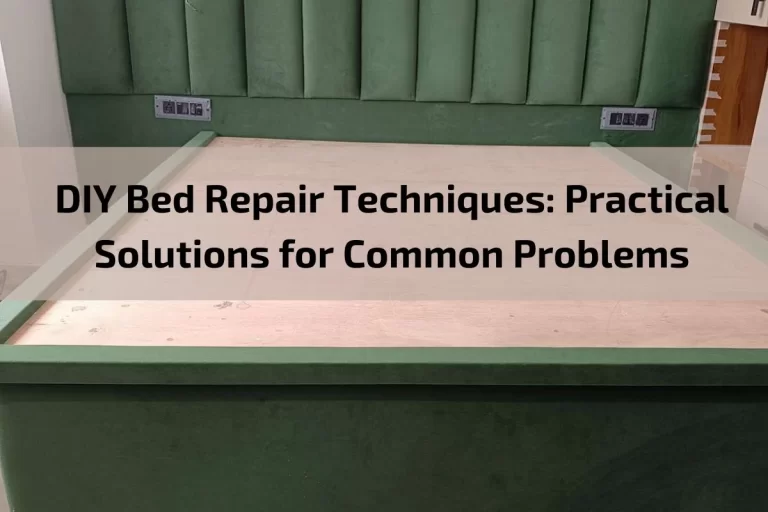Leather sofas are prized for their timeless elegance, durability, and luxurious appeal. However, over time, even the highest quality leather can show signs of wear and tear, such as scratches, tears, or fading. While professional leather repair services are available, embarking on a DIY journey to restore your leather sofa can be both rewarding and cost-effective.
In this guide, we will explore DIY leather sofa repair techniques aimed at restoring the beauty and durability of your cherished furniture piece. From patching up tears to rejuvenating faded leather, we’ll provide you with practical tips and step-by-step instructions to help you breathe new life into your leather sofa.
Whether you’re a novice DIY enthusiast or a seasoned craftsman, tackling leather sofa repairs yourself allows you to take control of the restoration process and customize solutions to suit your needs. So, let’s delve into the world of DIY leather sofa repair and discover how you can transform your worn-out sofa into a stunning centerpiece of your living space.
Overview of the Article’s Focus on DIY Leather Sofa Repair Techniques
Leather sofas exude sophistication and style, but over time, they may start showing signs of wear and tear. In this article, we’ll dive into the world of DIY leather sofa repair, offering practical tips and techniques to help you restore your beloved furniture piece to its former glory. From patching up tears and scratches to rejuvenating faded leather, we’ll guide you through the process step by step, empowering you to take control of the repair process. Whether you’re a seasoned DIY enthusiast or a newcomer to leather repair, this comprehensive guide will equip you with the knowledge and tools you need to breathe new life into your leather sofa. Get ready to roll up your sleeves and embark on a rewarding journey to enhance the beauty and durability of your leather furniture.
Importance of Maintaining and Repairing Leather Sofas for Longevity
Leather sofas are not just pieces of furniture; they are investments that add elegance and sophistication to our living spaces. However, like any investment, leather sofas require regular maintenance and occasional repairs to ensure their longevity and continued beauty. Here are several reasons highlighting the importance of maintaining and repairing leather sofas:
Preservation of Investment: Leather sofas often come with a significant price tag, making them valuable assets in our homes. Regular maintenance and timely repairs help protect this investment by preventing minor issues from escalating into costly problems that may require replacement.
Extended Lifespan: Leather is a durable and resilient material, but it requires care to maintain its integrity over time. Regular cleaning, conditioning, and repairs can significantly extend the lifespan of a leather sofa, allowing you to enjoy its comfort and beauty for years to come.
Enhanced Appearance: A well-maintained leather sofa adds an air of sophistication to any room. By addressing minor issues such as scratches, stains, or fading, you can keep your leather sofa looking its best and maintain the aesthetic appeal of your living space.
Comfort and Enjoyment: A well-cared-for leather sofa provides unparalleled comfort and relaxation. By keeping the leather clean, conditioned, and free of damage, you ensure that your sofa remains a cozy retreat for lounging, entertaining, and spending quality time with loved ones.
Health and Hygiene: Regular maintenance and cleaning of leather sofas contribute to a healthy indoor environment by removing dirt, dust, and allergens that may accumulate on the surface. This is particularly important for individuals with allergies or respiratory issues.
Sustainability: Repairing and maintaining leather sofas instead of replacing them aligns with principles of environmental sustainability. By extending the lifespan of furniture, we reduce waste and minimize our environmental footprint, contributing to a more sustainable way of living.
DIY Leather Sofa Repair Tools and Supplies
When it comes to repairing your leather sofa yourself, having the right tools and supplies is essential for achieving successful results. Here’s a list of the essential tools and supplies you’ll need for DIY leather sofa repair:
Leather Repair Kit: A comprehensive leather repair kit typically includes various colors of leather repair compound, adhesive, filler, and tools for applying and blending the repair materials.
Leather Conditioner: A high-quality leather conditioner helps moisturize and soften the leather, restoring its suppleness and preventing it from drying out and cracking.
Leather Cleaner: A specialized leather cleaner is necessary for removing dirt, stains, and grime from the surface of the leather without causing damage or discoloration.
Sandpaper: Fine-grit sandpaper is useful for smoothing rough edges, leveling out repairs, and preparing the surface of the leather for patching or refinishing.
Leather Patch: For repairing tears, holes, or large areas of damage, you’ll need a matching leather patch that closely matches the color and texture of your sofa’s leather upholstery.
Leather Dye or Paint: If your leather sofa has significant color loss or fading, you may need a leather dye or paint to restore its color and vibrancy. Choose a dye or paint specifically formulated for use on leather surfaces.
Upholstery Needle and Thread: A heavy-duty upholstery needle and strong thread are essential for stitching together torn or split seams in the leather upholstery.
Sponge or Applicator Pad: Use a sponge or applicator pad to apply leather cleaner, conditioner, dye, or paint evenly and smoothly onto the leather surface.
Protective Gloves: Wear protective gloves to protect your hands from coming into direct contact with repair chemicals and to prevent oils from your skin transferring onto the leather.
Lint-Free Cloths: Use lint-free cloths for wiping away excess cleaner, conditioner, or dye from the leather surface, ensuring a clean and streak-free finish.
Heat Gun or Hair Dryer: A heat gun or hair dryer can be used to speed up the drying process when applying leather repair compounds, adhesives, or dyes.
Masking Tape: Masking tape helps protect surrounding areas of the leather from accidental spills or damage during the repair process.
DIY Leather Sofa Repair Techniques
Repairing your leather sofa yourself can be a rewarding and cost-effective solution for addressing common issues and restoring its beauty and durability. Here are some DIY leather sofa repair techniques to help you tackle various problems effectively:
Patching Tears and Scratches:
- Leather Patch Repair: Cut a leather patch slightly larger than the tear or scratch, apply a small amount of adhesive to the back of the patch, and press it firmly onto the damaged area. Smooth out any air bubbles and allow the adhesive to dry completely before using the sofa.
- Color Matching: If necessary, use leather dye or paint to match the color of the patch to the surrounding leather upholstery. Apply multiple thin coats of dye or paint, allowing each layer to dry completely before applying the next one, until you achieve a seamless blend.
Rejuvenating Faded Leather:
- Leather Conditioning: Apply a liberal amount of leather conditioner to the entire surface of the sofa using a clean, lint-free cloth. Massage the conditioner into the leather in a circular motion, paying special attention to areas that are particularly dry or faded. Allow the conditioner to penetrate the leather for several hours or overnight before buffing it off with a dry cloth.
- Color Restoration: If the leather has significant color loss or fading, use a leather dye or paint to restore its original color. Apply the dye or paint evenly to the entire surface of the sofa using a sponge or applicator pad, following the manufacturer’s instructions carefully. Allow the dye or paint to dry completely before applying additional coats as needed.
Fixing Loose or Broken Stitching:
- Re-Stitching Seams: Thread an upholstery needle with strong thread that matches the color of the leather, and carefully restitch the torn or split seams using a sturdy backstitch or saddle stitch pattern. Knot the thread securely at the end of the seam and trim any excess. For added durability, apply a small amount of leather adhesive to the back of the seam before stitching.
- Seam Reinforcement: To prevent future seam damage, reinforce the repaired seams by applying a thin strip of leather adhesive along the underside of the seam. Press the adhesive firmly into place and allow it to dry completely before using the sofa.
Addressing Stains and Spills:
- Gentle Cleaning: Use a mild leather cleaner and a clean, damp cloth to gently blot away stains and spills from the leather surface. Avoid using harsh chemicals or abrasive cleaners, as these can damage the leather. Once the stain has been removed, dry the leather thoroughly with a clean, dry cloth.
Leather Sofa Care and Maintenance
Proper care and maintenance are essential for keeping your leather sofa looking its best and ensuring its longevity. Here are some tips for caring for and maintaining your leather sofa:
Regular Cleaning: Dust and debris can accumulate on the surface of your leather sofa over time, so it’s important to clean it regularly. Use a soft, dry cloth or a vacuum cleaner with a brush attachment to remove dust and loose dirt from the surface of the leather.
Spot Cleaning: Inevitably, spills and stains may occur on your leather sofa. Promptly blot spills with a clean, dry cloth to absorb as much liquid as possible. Avoid rubbing the stain, as this can cause it to spread. Use a mild leather cleaner and follow the manufacturer’s instructions for spot cleaning specific stains.
Avoid Harsh Chemicals: When cleaning your leather sofa, avoid using harsh chemicals or cleaners that contain alcohol or ammonia. These can damage the leather and cause it to dry out or crack over time. Instead, opt for gentle, leather-specific cleaners that are formulated to maintain the integrity of the leather.
Conditioning: Leather is a natural material that can dry out and become stiff over time. To keep your leather sofa soft and supple, apply a leather conditioner regularly. Conditioning helps to replenish the natural oils in the leather and prevent it from drying out and cracking. Apply the conditioner according to the manufacturer’s instructions, using a clean, lint-free cloth to massage it into the leather in a circular motion.
Protect from Sunlight: Direct sunlight can cause leather to fade and become discolored over time. To prevent this, position your leather sofa away from windows or use curtains or blinds to block out harsh sunlight. Additionally, consider using UV protectant sprays or applying window film to protect your leather sofa from UV damage.
Avoid Sharp Objects: Sharp objects such as keys, pens, or pet claws can scratch or puncture the surface of your leather sofa. Be mindful of what comes into contact with your sofa and avoid placing sharp objects on or near it. Consider using protective covers or arm caps to prevent accidental damage.
Rotate Cushions: If your leather sofa has removable cushions, rotate them regularly to distribute wear evenly and prevent sagging or indentations in the cushions.
Professional Cleaning and Maintenance: While regular at-home care is important, consider scheduling professional leather cleaning and maintenance services periodically. Professional cleaners have the expertise and specialized equipment to deep clean and rejuvenate your leather sofa, ensuring it stays in top condition for years to come.
Conclusion
In conclusion, caring for and maintaining your leather sofa is essential for preserving its beauty, comfort, and longevity. By following the tips outlined in this guide, you can keep your leather sofa looking its best and ensure that it remains a cherished piece of furniture in your home for years to come.








